Mushroom clouds of WTC

http://doujibar.ganriki.net/english/e-wtc1_others/wtc1-demoblast1.jpg URL: http://doujibar.ganriki.net/english/e-01a-wtc1upperfloors-2.html Caption: WTC 1
Cloud, darkness and smoke plume
Cloud cover

http://www.luogocomune.net/site/modules/911/index.php?filename=911/7-Misc/stampa/focus/focus.html
Also there was supposed to be 200,000+ gallons of water on the roof of each tower – this water was spilled into stairwells etc, but was later all converted into water vapor reducing the initial brown color of the clouds.
ABOVE FROM: http://www.saunalahti.fi/wtc2001/soldier4.htm (Observations Suggesting the Use of Small Hydrogen Bombs)
The bomber, piloted by the commander of the 509th Composite Group, Colonel Paul Tibbets, flew at low altitude on automatic pilot before climbing to 31,000 feet as it neared the target area. At approximately 8:15 a.m. Hiroshima time the Enola Gay released “Little Boy,” its 9,700-pound uranium bomb, over the city . . . the crew looked back at Hiroshima. “The city was hidden by that awful cloud . . . boiling up, mushrooming, terrible and incredibly tall,” Tibbets recalled. The yield of the explosion was later estimated at 15 kilotons (the equivalent of 15,000 tons of TNT). [Hiroshima]
FROM: http://www.mbe.doe.gov/me70/manhattan/hiroshima.htm
Yukiharu did not realize at first that a bomb had exploded. He thought there had been an electrical accident at the plant building he was working in. Then it suddenly became dark and “I heard a huge explosion.” [Hiroshima]
FROM: http://users.dickinson.edu/~history/product/steele/seniorthesis.htm
The Hiroshima Meteorological Observatory reported that just after the flash, black smoke rose from the ground up to the sky reaching an altitude of several thousand meters, and covered the whole city. When the fireball disappeared, the angry clouds, like grey smoke, rose and reached an altitude of 8,000 meters in 5 minutes after the explosion.
One of the Enola Gay crew recorded in his flight diary, “9:00a.m [..] Clouds were observed. Altitude of 12,000 meters or more.” From a distance the cloud formation looked like a mushroom growing out of the ground, with white cloud at the top and yellowish clouds enveloping reddish-black clouds, creating a color that cannot be described as while, black, red or yellow. [Hiroshima]
FROM: http://www.gensuikin.org/english/photo.html
Pitch darkness descended after the explosion
by Tsutomu Igarashi
In Chiyoko Kuwabara’s testimony, she mentioned that “it got pitch-dark” right after the explosion. In others’ atomic-bomb testimonies on record, we often find descriptions of “a shroud of darkness”. What’s the cause of it? [..]
At the point of atomic-bomb explosion above ground zero, “the temperature rose up to the extreme heat of a few million degrees Celsius and a fireball of several hundred thousand atmospheric pressures was created”, the Report says. It continues that “following that explosion the bomb blast (a shock wave and the blast wind), heat rays (infrared rays and visible rays) and initial radiation (gamma ray and neutron) were emitted.” [..]
What happened at first was that, by the creation of a fireball, heat rays were emitted and everything was incinerated in a split second. Even on the ground in the hypocenter vicinity, temperatures reached several thousand degrees Celsius. Melted roof tiles and glass can verify that. Heat rays burned out everything. But it only lasted a moment. It says “The fireball blazed for ten seconds”, but I presume in fact it blazed for a second or two and lost its intense heat rapidly. So we can suppose that everything was ignited at that moment due to the heat of several thousand degrees Celsius.
Every organism exposed directly to the heat rays was burned. Trees, grass, houses, and walls, anything burnable was charred when they were exposed to the heat rays and their surfaces also became rough and were bubbled by the intense heat. [..] Numerous fine particles like dust and specks are suspended in the air. Those particles would be charred in a moment.
Related to this, U. S. bombers like the Enola Gay were strictly prohibited to bomb with radar; bombing by sight was always required. After studying the long term records of weather, they intentionally chose a fine clear day. The U.S. Forces really emphasized bombing by sight. [..]
I guess the U.S. already knew about the phenomenon of particles in the air burning and had its data. Charred particles were one of the factors causing the darkness we can’t overlook.
What also burned was the skin of animals and people’s clothes, as Kunio NAGATA, teacher at Hiroshima Municipal Ujina junior high school, mentioned.
When hibakusha were badly damaged by the atomic bombing, they were almost naked. Where were their clothes? At the first stage of the explosion the clothes exposed to the heat got charred and tattered instantaneously. And the heat rays penetrated the clothes, more heat absorbed at the dark parts of clothes, and then burned the skin. The skin also got burned and was hanging like rags. Naturally some parts of their hair got burned, too.
At the second stage, the blast came with the velocity of several hundred meters per second, sweeping away those charred organic materials. So what was left were people whose clothes and burnt skin had been swept away. People were naked or had their flesh exposed without skin. At the same time dirt and burned objects rushed back to them, made their faces filthy, terribly distorting their appearances. The blast wind would carry away some parts of the tissue-damaged skin. There were many people with the remnants of their torn skin hanging from their bodies. [..]
The air that rushed in contained all sorts of burnt objects you can think of, including soot, dirt, dust, and the wreckage of buildings, blowing back towards the point of detonation 580 meters above the ground. Inorganic matter didn’t change color much but organic matter got charred and rushed back in. Trees, grass, particles in the air, skins of creatures, clothes, charred human skin and hair, all were absorbed and concentrated. Those which heated to a higher temperature went up further from the central point, forming a huge umbrella which was the lower part of the mushroom cloud. The reason that the lower part of the cloud was dark was that it contained incinerated objects. It was not just due to dirt or debris. We should assume that only incinerated objects which have lighter mass could go that high up.
Those objects went up to the sky and immediately formed a kind of a dome. Directly below it objects had already ignited and were flaming up. With this heat some parts kept rising up forming cumulonimbus cloud. The dome with a 1 kilometer- radius containing these incinerated substances was formed in the sky over ground zero, light was blocked and the ground was shrouded in darkness. This was what happened in just dozens of seconds.
The top of mushroom cloud reached about 9000 meters high 8 minutes after the explosion.
Just then the wind was blowing from south-east. The rising cumulonimbus cloud drifted to the north-west as time went by, then was exposed to cold air and became rain that fell on the ground. This is “black rain”. The black rain contained charred organisms, namely burned human skins, hair and burned up clothes. This black rain also contained a great deal of radioactive substances.
The dozens of minutes of darkness generated by the atomic bombing symbolizes the tremendous power and its realities of it. It can be said that the fact that people were stripped naked in a split second led to this dome of darkness. We can also say the dome contained [a] very small amount of burnt skin and clothes and blocked light.
FROM: http://homepage2.nifty.com/hiroshimaaozora/yamiEnglish.htm
Darkness at the World Trade Center

IMG: http://www.media-collections.com/pictures/Ground_Zero_Streets_19.jpg
FROM: http://www.media-collections.com/pictures/index.html

IMG: http://luogocomune.net/site/modules/911/911/7-Misc/debunk/crono/6fog-o.jpg FROM: http://www.luogocomune.net/site/modules/911/index.php?filename=911/7-Misc/stampa/focus/focus.html

IMG: http://luogocomune.net/site/modules/911/911/7-Misc/debunk/crono/6fog-o.jpg FROM: http://www.luogocomune.net/site/modules/911/index.php?filename=911/7-Misc/stampa/focus/focus.html

IMG: http://drjudywood.com/articles/DEW/dewpics/Image35swamp.jpg FROM: http://drjudywood.com/articles/DEW/moretoastedcars.html
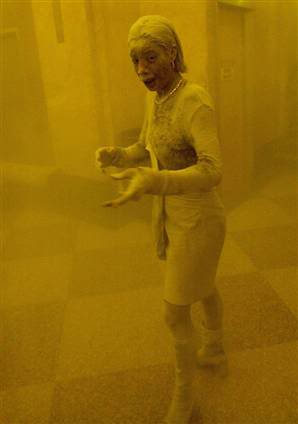
CAPTION: Marcy Borders was caught outside as one of the World Trade Center towers collapsed and a cloud of smoke and dust enveloped the area. Officials are concerned about the possible longterm health effects of the dust. (Stan Honda / AFP file) IMAGE: http://msnbcmedia2.msn.com/j/msnbc/Components/Photos/060424/060424_911Dust_vmed_2p.grid-4×2.jpg FROM: http://www.msnbc.msn.com/id/12466875/


http://www15.ocn.ne.jp/~oyakodon/newversion/pic11/WTC05.jpg FROM: http://www15.ocn.ne.jp/~oyakodon/newversion/hb1.htm

http://www.911dust.org/images/people-walking-dust-cloud.jpg URL: http://www.911dust.org/

Caption: NEW YORK – SEPTEMBER 11: New York City firefighters and journalists stand near the area known as Ground Zero after the collapse of the Twin Towers September 11, 2001 in New York City. © Photo by REUTERS/Anthony Correia IMG: http://www.digitaljournalist.org/issue0609/assign/images/ac4a.jpg URL: http://www.digitaljournalist.org/issue0609/assign/ac_journal0609.htm

Caption: People run from the collapse of World Trade Center Tower Tuesday, Sept. 11, 2001 in New York. (AP Photo/Suzanne Plunkett) IMG: http://www.cincinnati.com/news/towerphotos/people_running.jpg URL: http://www.cincinnati.com/news/towerphotos/people_running.html

Caption: Running from WTC collapse dust. Fair use, dmca. Continue reading at NowPublic.com. Study: 70K may suffer post-9/11 stress disorder | NowPublic Photo Archives URL: http://www.nowpublic.com/world/study-70k-may-suffer-post-9-11-stress-disorder-1#ixzz1C9tzhyDo IMG: http://media.nowpublic.net/images//69/c/69c09429ccdbb1a5ce440071c2166440.jpg URL: http://www.nowpublic.com/world/study-70k-may-suffer-post-9-11-stress-disorder-1

IMG: http://4.bp.blogspot.com/_h7CJteTPowo/RuZKebDKYzI/AAAAAAAABwY/Rvj_yt0TnFk/s1600/running.jpg URL: http://www.fourwinds10.com/siterun_data/government/fraud/911_attack/news.php?q=1284401650

IMG: http://www.bobbyshred.com/images/wtc46dasdasm.jpg URL: http://www.bobbyshred.com/twintowers.html
Video – People being chased by the pyroclastic surge clouds
VIDEO: “Extreme Closeup of World Trade Center WTC Tower Collapse” [dailymotion | Youtube]
Image from video:

Pyrocumulus clouds in Hiroshima

Caption: Several photographs were taken from the ground after the blast, by residents of adjacent valleys which were shielded from the direct effects of the explosion. IMG: http://www.richard-seaman.com/Travel/Japan/Hiroshima/AtomicBombMuseum/DamageToCity/AtomicBombPhotosFromGround1.jpg URL: http://www.richard-seaman.com/Travel/Japan/Hiroshima/AtomicBombMuseum/DamageToCity/index.html
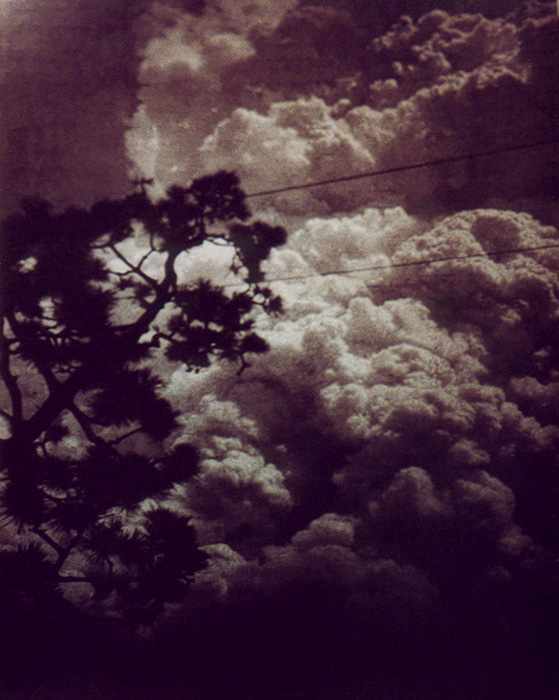
Caption: Several photographs were taken from the ground after the blast, by residents of adjacent valleys which were shielded from the direct effects of the explosion. IMG: http://www.richard-seaman.com/Travel/Japan/Hiroshima/AtomicBombMuseum/DamageToCity/AtomicBombPhotosFromGround2.jpg URL: http://www.richard-seaman.com/Travel/Japan/Hiroshima/AtomicBombMuseum/DamageToCity/index.html
Interview with Patricia Ondrovic
Killtown: What did you do when the South Tower started coming down?
Patricia Ondrovic: I didn’t know what was happening, but there was a loud “roar” — lots of crashing sounds. I was attempting to put my stretcher back into the vehicle. The ground was shaking and I saw a sea of people, mostly the various agencies on scene, Fire, Police, EMS, all running towards me. I had no idea what they were running from, but I decided I’d be ahead of them and just started running west towards the river. As I was running, parked cars were blowing up and some were on fire, the street was cracking a bit as well. Very shortly after I started running, everything became one big black cloud. I was near the West Side Highway and I couldn’t see around me anymore.
FROM: http://killtown.blogspot.com/2006/02/911-rescuer-saw-explosions-inside-wtc.html
Chemical Analysis
In the first four hours after two planes hit the WTC towers, a massive cloud of dust and smoke from the collapse and explosions filled the air. “Basically, you had blackout,” Lioy said. The dust gradually settled, resuspended, and settled again over the next few days. On the third and fourth days, it rained and the dust in the air diminished. Fires continued to burn and the plume lofted, yet was intermittently pushed down by inversions. On the 13th day, search and rescue was abandoned, diesel engines started up, and the site became a construction zone. A plume of smoke rose from ground zero until the fires were extinguished on Dec. 20.
FROM: http://pubs.acs.org/cen/NCW/8142aerosols.html
Pyrocumulus clouds
VIDEO: Pyrocumulus clouds appear after the WTC attacks (“Wtc1_stairway_hot”)
URL: http://www.dailymotion.com/pshon/video/x2skya_wtc1stairwayhot_politics
QUOTE: Survivor in WTC 1 stairwell during WTC 2 collapse: “… all of a sudden this huge cloud of dark grey smoke comes shooting up the stairway … and it was hot – very, very hot.”
URL: http://whatreallyhappened.com/WRHARTICLES/thermite.php
Dust cloud and white plume
VIDEO: “Wtc2_smoke” [Dailymotion]
FROM: http://whatreallyhappened.com/WRHARTICLES/thermite.php
IMAGE: White smoke emerging from the dust cloud of the collapsing WTC 2.
Mushroom cloud and explosion cloud
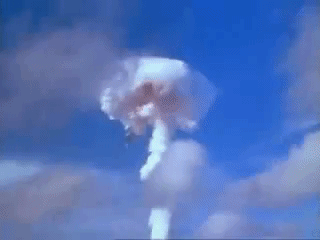
Mushroom cloud video
VIDEO: “MUSHROOM CLOUD” [Dailymotion | Atomic Archive]
The mushroom cloud consists chiefly of very small particles of radioactive fission products and weapon residues, water droplets, and larger particles of dirt and debris carried up by the afterwinds. The color of the cloud is initially red or reddish brown, due to the presence of nitrous acid and oxides of nitrogen. As the fireball cools and condensation occurs, the color changes to white, mainly due to the water droplets as in an ordinary cloud.
URL: http://www.atomicarchive.com/Movies/mushroomcloud.shtml

Mushroom cloud – from Wikipedia
A mushroom cloud is a distinctive pyrocumulus mushroom-shaped cloud of condensed water vapor or debris resulting from a very large explosion. They are most commonly associated with nuclear explosions, but any sufficiently large blast will produce the same sort of effect. They can be caused by powerful conventional weapons like the GBU-43/B Massive Ordnance Air Blast bomb. Volcano eruptions and impact events can produce natural mushroom clouds.
Mushroom clouds form as a result of the sudden formation of a large mass of hot, low-density gases near the ground creating a Rayleigh–Taylor instability. The mass of gas rises rapidly, resulting in turbulent vortices curling downward around its edges, forming a vortex ring and drawing up a column of additional smoke and debris in the center to form its “stem”. The mass of gas eventually reaches an altitude where it is no longer of lower density than the surrounding air and disperses, the debris drawn upward from the ground scattering and drifting back down (see fallout).
http://en.wikipedia.org/wiki/Mushroom_cloud
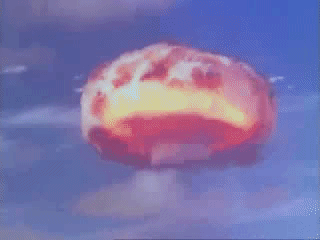
Base surge
A pyroclastic surge is a fluidized mass of turbulent gas and rock fragments which is ejected during some volcanic eruptions. It is similar to a pyroclastic flow but contains a much higher proportion of gas to rock, which makes it more turbulent and allows it to rise over ridges and hills rather than always travel downhill as pyroclastic flows do.
Pyroclastic surges are much faster moving than pyroclastic flows, and can reach speeds of 1050 km/h. Pyroclastic flows may generate surges. For example, the city of Saint-Pierre on the Caribbean island of Martinique in 1902 was overcome by one.
Base surge was first recognised after the Taal Volcano eruption of 1965, where a visiting volcanologist recognised the phenomenon as congruent to base surge in atomic explosions. The USGS defines base surge as turbulent, low-density cloud of rock debris and water and (or) steam that moves over the ground surface at high speed. Base surges are generated by explosions.
Hot surges contain gas and steam at temperatures above 100 °C (212 °F) and are ejected from the vent. They may be as hot as 800 °C (1500 °F) and are produced by the same mechanisms as pyroclastic flows. [..]
Surges can travel around 10 kilometres (6.2 miles) and are enormously destructive because of their massive kinetic energy and, for hot surges, the lethally hot gas.
http://en.wikipedia.org/wiki/Base_surge
Sedan test
Storax Sedan was a shallow underground nuclear test conducted in Area 10 of Yucca Flat at the Nevada National Security Site on 6 July 1962 as part of Operation Plowshare, a program to investigate the use of nuclear weapons for mining, cratering, and other civilian purposes. [..]
Sedan was a thermonuclear device with a fission yield less than 30% and a fusion yield about 70%. The timing of the test put it within the Operation Storax fiscal year, but Sedan was functionally part of Operation Plowshare, and the test protocol was sponsored and conducted by Lawrence Livermore National Laboratory with minimal involvement by the United States Department of Defense. The explosive device was lowered into a shaft drilled into the desert alluvium 194 m (636 ft) deep. The fusion-fission blast had a yield equivalent to 104 kilotons of TNT (435 terajoules) and lifted a dome of earth 290 feet (90 m) above the desert floor before it vented at three seconds after detonation, exploding upward and outward displacing more than 11,000,000 t (11,000,000 LT; 12,000,000 ST) of soil. The resulting crater is 100 m (330 ft) deep with a diameter of about 390 m (1,280 ft). A circular area of the desert floor five miles across was obscured by fast-expanding dust clouds moving out horizontally from the base surge, akin to pyroclastic surge. The blast caused seismic waves equivalent to an earthquake of 4.75 on the Richter scale. [..]
The Plowshare project developed the Sedan test in order to determine the feasibility of using nuclear detonations to quickly and economically excavate large amounts of dirt and rock. Proposed applications included the creation of harbors, canals, open pit mines, railroad and highway cuts through mountainous terrain and the construction of dams. Assessment of the full effects of the Sedan shot showed that the radioactive fallout from such uses would be extensive. Public concerns about the health effects and a lack of political support eventually led to abandonment of the concept.
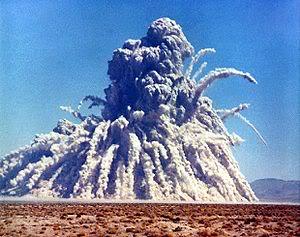
Caption: Storax Sedan explosion IMG: http://upload.wikimedia.org/wikipedia/commons/thumb/7/7d/Storax_Sedan_nuke.jpg/300px-Storax_Sedan_nuke.jpg URL: http://en.wikipedia.org/wiki/Sedan_%28nuclear_test%29
Sedan Test
VIDEO: “Sedan Nuclear Test – Original Military Film” [Dailymotion | Youtube]
IMAGE: Still from Sedan Test
http://en.wikipedia.org/wiki/Sedan_%28nuclear_test%29
Underground nuclear testing
Underground nuclear testing refers to test detonations of nuclear weapons that are performed underground. When the device being tested is buried at sufficient depth, the explosion may be contained, with no release of radioactive materials to the atmosphere.
The extreme heat and pressure of an underground nuclear explosion causes changes in the surrounding rock. The rock closest to the location of the test is vaporised, forming a cavity. Further away, there are zones of crushed, cracked, and irreversibly strained rock. Following the explosion, the rock above the cavity may collapse, forming a rubble chimney. If this chimney reaches the surface, a bowl-shaped subsidence crater may form. [..]
The first underground nuclear test was conducted on 29 November 1951. This was the 1.2 kiloton Buster-Jangle Uncle, detonated 5.2 m (17 ft) beneath ground level. The test was designed as a scaled-down investigation of the effects of a 23 kiloton ground penetrating gun-type device that was then being considered for use as a cratering and bunker-buster weapon. The explosion resulted in a cloud that rose to 11,500 ft, and deposited fallout to the north and north-northeast. The resulting crater was 260 feet wide and 53 feet deep.
The next underground test was Teapot Ess, on 23 March 1955. The 1 kiloton explosion was an operational test of an atomic demolition munition (ADM). It was detonated 67 feet underground, in a shaft lined with corrugated steel, which was then back-filled with sandbags and dirt. Because the ADM was buried underground, the explosion blew tons of earth upwards, creating a crater 300 feet wide and 128 feet deep. The resulting mushroom cloud rose to a height of 12,000 feet and subsequent radioactive fallout drifted in an easterly direction, travelling as far as 225 km from ground zero. [..]
The effects of an underground nuclear test may vary according to factors including the depth and yield of the explosion, as well as the nature of the surrounding rock. If the test is conducted at sufficient depth, the test is said to be contained, with no venting of gases or other contaminants to the environment. [..] One figure used in determining how deeply the device should be buried is the scaled depth of burial, or -burst. This figure is calculated as the burial depth in metres divided by the cube root of the yield in kilotons. It is estimated that, in order to ensure containment, this figure should be greater than 100.
The energy of the nuclear explosion is released in one microsecond. In the following few microseconds, the test hardware and surrounding rock are vaporised, with temperatures of several million degrees and pressures of several million atmospheres. Within milliseconds, a bubble of high-pressure gas and steam is formed. The heat and expanding shock wave cause the surrounding rock to vaporise, or being melted further away, creating a melt cavity. The shock-induced motion and high internal pressure cause this cavity to expand outwards, which continues over several tenths of a second until the pressure has fallen sufficiently, to the level equal to the level roughly comparable with the weight of the rock above, and can no longer grow. Although not observed in every explosion, four distinct zones (including the melt cavity) have been described in the surrounding rock. The crushed zone, about two times the radius of the cavity, consists of rock that has lost all of its former integrity. The cracked zone, about three times the cavity radius, consists of rock with radial and concentric fissures. Finally, the zone of irreversible strain consists of rock deformed by the pressure. The following layer undergoes only an elastic deformation; the strain and subsequent release then forms a seismic wave. [..]
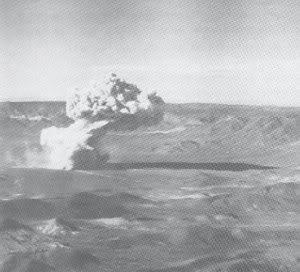
Caption: The 1951 Uncle test – the first underground nuclear explosion
FROM: http://en.wikipedia.org/wiki/Underground_nuclear_testing
Video – Underground nuclear test
Caption: “Underground Nuclear Test” – Subsidence Crater Formation. Historic underground nuclear test causes the surface to subside which forms a crater – seven such craters are used as disposal cells at the Area 3 Radioactive Waste Management Site. Provided by the US Department of Energy under Public Domain rules. [Dailymotion | Youtube]
COMMENT: Many surge clouds form at the base.
Video of underground test – Teapot Ess
Caption: “Underground nuclear testing Teapot Ess” – The first time released Ess shot film in full color. This LASL test was the sixth to use the Ranger Able U-235 core, this time in a Mk-6 HE assembly. Ess (“Effects Sub-Surface”) was a test of atomic demolition munition (ADM) cratering. The 8000 lb bomb was placed in a shaft lined with corrugated steel,10 feet wide and 70 feet deep (so that the bomb center was at -67 feet), which was back-filled with sandbags and dirt prior to firing. The crater was 300 feet wide and 128 feet deep. [Dailymotion | Youtube]
Video – Tsar Bomba
VIDEO: “Tsar Bomba” – This was a Soviet thermonuclear bomb and was the biggest bomb ever made. Many surge clouds can be observed during the explosion. [Dailymotion]
Possibilities for Peaceful Nuclear Explosives
The first formal programme for peaceful applications was announced by the USA in 1957, under the title ” Plowshare “. [..]
In 1961 and subsequently, the USA again performed underground nuclear experiments, including the first nuclear Plowshare test, project GNOME. Since then, experience has been accumulated and codified, and it is possible to consider international applications of a commercial nature.
What happens underground
In order to understand better the possible applications which have been proposed, it is useful to review and discuss what happens in an underground nuclear explosion.
In the first phase of firing (which lasts only for millionths of a second) almost all the energy of the nuclear explosion is released. A fireball, in which internal temperatures of millions of degrees and internal pressures of millions of atmospheres exist, is formed. The surrounding rock is vapourised by absorption of energy from radiant heat and other radiations, with a boundary of molten rock. Thus, a cavity several metres across may be formed.
Within a few thousandths of a second, the pressure wave within the cavity strikes the cavity wall. The cavity is further expanded by plastic deformation of the surrounding rock, and the fluid layer increases in thickness through melting following some absorption of the mechanical energy. Most of the pressure energy is converted into a shock wave which travels outward from the explosion. Until its energy has been dissipated, this Shockwave interacts with the surrounding rock by crushing and fracturing it. This behaviour, as is the case with the other shock phenomena described below, is not qualitatively different from the effects of chemical high explosive shots; the differences are in scale – the much larger energy in the nuclear shock and the smaller relative size of the central cavity.
Within a period of seconds, the molten rock liner of the cavity starts to flow and aggregates at the bottom. This molten zone contains most of the radioactivity of the nuclear explosion. Ultimately it will freeze, and it is finally found as a bowl-shaped mass, considerably cracked as a result of thermal stresses and of mechanical blows from other rock falling on to it.
In a contained explosion, the fractured rock zone above the cavity is not solid enough to bridge over the hole. Some of the broken rock falls in from above, filling the cavity with looser rock. As this happens, more rock continues to fall from above, until the point is reached at which this relatively loosely packed region begins again to support the rock above it, and the less badly shattered rock acts as a bridge. The result is a cylinder filled to low density with broken rock, called a “chimney”. If the explosion is deep underground, no surface effect can be seen. It is possible, however, for chimney formation to result in some slumping of the earth at ground level; if the explosion were too close to the surface, the chimney could extend to the surface, and cracks in the ground would be found.
For cratering activities, the explosive is detonated at a depth such that the shock wave will reach the surface and be partially reflected and refracted at the ground-air interface. The returning wave reaches the cavity while it is still growing, and causes it to expand preferentially upward and outward.
As a result, a large dome of earth and rock rises above ground level. Ultimately the dome is breached, through a combination of effects: decreased cavity pressure from its expansion, release of cavity gas through fissures in the dome, and gravity. Then the dome falls back; however, by this time a large mass of material has been pushed outward. The result is a crater, with a rim of crushed, loose rock, and a floor of broken rock lying above the location of the detonation. The molten and resolidified rock zone still exists, but is buried under the crater floor.
As indicated, the largest part of the radioactivity in the nuclear explosion is retained in the molten zone. Most of the rest is retained on the surfaces of the crushed and fractured rocks, which are good natural sieves for particulate matter and absorbers for vapour. In a cratering explosion, however, some radioactivity will escape to the atmosphere. The amount of fission products is estimated as a very small fraction of the potential quantity: in a 25 kiloton explosion, which is largely thermonuclear, fission product release is limited to the products of a 20 ton fission explosion – about 8 grammes of product. Neutron activation is minimised by surrounding the explosive with a non-activating, neutron absorbing shield. Some tritium from the thermonuclear explosion is released.
Comparisons with TNT
As has been mentioned, the nuclear explosion differs in equivalent size from chemical high explosives by several orders of magnitude. A 25 kiloton nuclear explosive (TNT equivalent – 2 5 000 tons) may be emplaced in a cylindrical bore hole less than a metre in diameter; even a 1 megaton explosive charge (TNT equivalent – 1 000 000 tons) would not take up more space than that. On the other hand, 25 000 tons of TNT would require a spherical cavity, 30 metres in diameter. Even if that much TNT could be assembled in one place, its emplacement costs would be enormous.
(In this article Bernard I. Spinrad, Director of the Division of Nuclear Power and Reactors, summarizes information at present available.)
100 kiloton shallow underground burst
2 SECONDS
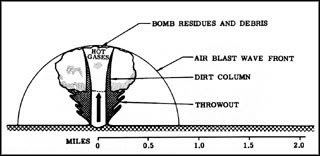
Figure 2.93a. Chronological development of a 100 kiloton shallow underground burst; 2 seconds after detonation.
When a nuclear explosion occurs at a shallow depth underground, the fireball breaks through the surface of the earth within a fraction of a second of the instant of detonation. The intensely hot gases at high pressure are released and they carry up with them into the air large quantities of soil, rock, and debris in the form of a hollow column. For a burst at a shallow depth, the column tends to assume the shape of an inverted cone which fans out as it rises, to produce a radial throw-out. A highly radioactive cloud, which contains large quantities of earth, is formed above the throw-out as the hot vapors cool and condense. Because of the mass displacement of material from the earth’s surface, a crater is formed. For a 100-kiloton weapon exploding 50 feet beneath the surface of dry soil, the crater would be about 120 feet deep and 720 feet across. The weight of the material removed would be over a million tons.
In addition to the shock (or pressure) wave in the ground, somewhat related to an earthquake wave, the explosion is accompanied by a blast wave in the air. At 2 seconds after the explosion, the blast wave front in air is about 3/4 mile from surface zero.
9 SECONDS
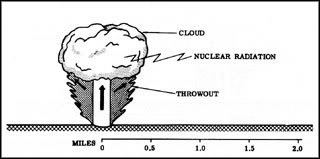
Figure 2.93b. Chronological development of a 100 kiloton shallow underground burst; 9 seconds after detonation.
The radioactive cloud continues to rise, giving off intense nuclear radiations which are still a hazard on the ground at 9 seconds after the detonation. At this time, the larger pieces of rock and debris in the throw-out begin to descend to earth.
45 SECONDS
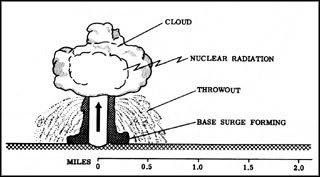
Figure 2.93c. Chronological development of a 100 kiloton shallow underground burst; 45 seconds after detonation.
As the material from the column descends, the finer soil particles attain a high velocity and upon reaching the ground they spread out rapidly to form a base surge similar to that in an underwater explosion. The extent of the base surge, which is likely to be radioactive, depends upon many factors, including the energy yield of the explosion, the depth of burst, and the nature of the soil. It is believed that a dry sandy terrain would be particularly conducive to base surge formation.
4.5 MINUTES
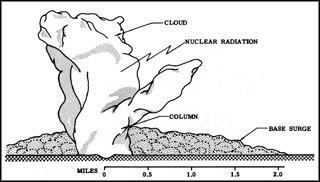
Figure 2.93d. Chronological development of a 100 kiloton shallow underground burst; 4.5 minutes after detonation.
The base surge increases in height and area and soon begins to merge with the radioactive cloud of weapon residues, etc., part of which descends and spreads out under the influence of the prevailing winds. In due course, the radioactive clouds disperse, but the contaminated particles descend to earth to produce a hazardous fallout over a large area, especially in the downwind direction, during the course of a few hours.
From The Effects of Nuclear Weapons, Samuel Glasstone, ed., USAEC, Washington, DC, April 1962; Revised Edition reprinted February 1964.
Digital version by Gregory Walker (trinatomic at earthlink dot net).
Copyright © 1995-2003 Gregory Walker (trinatomic at earthlink dot net), Creator of Trinity Atomic Web Site.
http://www.cddc.vt.edu/host/atomic/nukeffct/undrwtr.html
Base surge
US Defense Department Military Dictionary: base surge
(DOD, NATO) A cloud which rolls out from the bottom of the column produced by a subsurface burst of a nuclear weapon. For underwater bursts the surge is, in effect, a cloud of liquid droplets which has the property of flowing almost as if it were a homogeneous fluid. For subsurface land bursts the surge is made up of small solid particles but still behaves like a fluid.
http://www.answers.com/topic/base-surge
Mushroom cloud forming as the North Tower explodes

Mark 2: North Tower mushroom cloud. Note the brightening in the last phase.


Mark 2 Second image: Underground testing.



http://911research.wtc7.net/wtc/evidence/photos/dust.html#south
South Tower mushroom develops as it explodes

http://911research.wtc7.net/wtc/evidence/photos/dust.html#south

MK 2: South Tower mushroom cloud
http://911research.wtc7.net/wtc/evidence/photos/dust.html#south

URL: http://home.comcast.net/~jeffrey.king2/wsb/The_Strange_Collapse_of_the_Spire.htm

URL: http://911research.wtc7.net/wtc/evidence/photos/wtc2dust4.html

URL: http://home.comcast.net/~jeffrey.king2/wsb/The_Strange_Collapse_of_the_Spire.htm

URL: http://glasstone.blogspot.com/

Image: http://www.thewe.cc/thewei/_/images11/us_war_crimes/nuclear_explosion.jpe URL: http://www.thewe.cc/weplanet/news/asia/japan/hiroshima_cover_up.htm Caption: Photo: english.pravda.ru

IMG: http://www.thewe.cc/thewei/_/images11/us_war_crimes/hydrogen_bomb.jpe URL: http://www.thewe.cc/weplanet/news/asia/japan/hiroshima_cover_up.htm

Unknown origin of first image-probably a South American volcano similar to picture taken here: http://faculty.etsu.edu/delucia/photo_gallery.htm

Caption: Inside a mushroom cloud: cooler air is drawn into the rising toroidal fireball, which itself cools into the familiar cloud appearance. IMG: http://upload.wikimedia.org/wikipedia/commons/thumb/1/16/Mushroom_cloud.svg/230px-Mushroom_cloud.svg.png URL: http://en.wikipedia.org/wiki/Mushroom_cloud
Mushroom cloud of Nagasaki explosion
VIDEO: “NAGASAKI” – Nagasaki atomic bombing. Mushroom clouds are typical of nuclear explosions. [Dailymotion]
ALT URL: http://www.atomicarchive.com/Movies/Flash/nagasaki.swf

Mushroom clouds captured in the act of forming

http://www.serendipity.li/wot/finn/5/soldier5.htm

http://www.serendipity.li/wot/finn/5/soldier5.htm

http://www.serendipity.li/wot/finn/5/soldier5.htm

Img: http://www.serendipity.li/wot/finn/5/nuke1000.jpg URL: http://www.serendipity.li/wot/finn/5/soldier5.htm Caption: Sedan test Operation Storax
Abnormal brightening of the screen
VIDEO: You can see the abnormal brightening of the screen in the left shot as well as the similarity to the explosion cascade (streamers) of the nuclear (Storax) explosion. (“911 Eyewitness 400 first responder radiation cancers indicate MICRO FUSION”) [Dailymotion | Youtube]
Debris plumes and cascades

URL: http://drjudywood.com/articles/why/why_indeed.html

Caption: Navy photographer pictures suffering and ruins that resulted from atom bomb blast in Hiroshima, Japan. Japanese soldier walks through leveled area., 09/1945 IMG: http://www.atomcentral.com/NTS_project/080-G-%7E1_sm.jpg URL: http://www.atomcentral.com/HN_Images01.html
Chagan nuclear test

Caption: This is a picture of a 1965 Soviet test called “Chagan”. IMG: http://nuclearweaponarchive.org/Russia/Chagan1s.jpg URL: http://nuclearweaponarchive.org/Russia/Sovwpnprog.html
The 1965 Chagan nuclear test in the Soviet Union was used to create a dam on the Semipalatinsk river.
FROM: http://en.wikipedia.org/wiki/Peaceful_nuclear_explosions

ABOVE IMAGE: http://drjudywood.com/articles/dirt/dirt1.html

Caption: This is a picture of a 1965 Soviet test called “Chagan”. IMG: http://nuclearweaponarchive.org/Russia/Chagan1s.jpg URL: http://nuclearweaponarchive.org/Russia/Sovwpnprog.html


Caption: This is a picture of a 1965 Soviet test called “Chagan”.Img 1: http://www.drjudywood.com/articles/dirt/dirtpics/bubbler.jpg from URL: http://www.drjudywood.com/articles/dirt/ Img 2: http://nuclearweaponarchive.org/Russia/Chagan1s.jpg URL: http://nuclearweaponarchive.org/Russia/Sovwpnprog.html
 .
.
Caption: A mushroom cloud rises above Fangataufa Lagoon, French Pacific Possessions, following detonation of France’s first hydrogen bomb, August 24, 1968. Image: Corbis. http://media.npr.org/programs/totn/features/2005/11/nuclear/200_nuclear.jpg?t=1248631302 URL: http://www.npr.org/templates/story/story.php?storyId=4994158

URL: http://911research.wtc7.net/wtc/evidence/photos/wtc2dust1.html

URL: http://volcanoes.usgs.gov/Products/Warn/dds39_083_caption.html (inactive link)
Clouds above Hiroshima



CAPTION: Photos of the mushroom cloud. Photo by Gonichi Kimura Donated by the family of Gonichi Kimura. Approx. 4,000m from the hypocenter; photographed on the grounds of the Army Marine Training Division. Gonichi Kimura, a member of the Army Photographers’ Team, photographed the mushroom cloud several times about 15 minutes after the bombing. IMG: http://www.pcf.city.hiroshima.jp/vir URL: http://www.pcf.city.hiroshima.jp/virtual/img/ex0607_img/49_KG001.jpgtual/VirtualMuseum_e/exhibit_e/exh0607_e/exh060706_e.html
Fat Man – the bomb dropped on Nagasaki

Caption: THE ATOMIC BOMBING OF NAGASAKI. Nagasaki (August 9, 1945) URL: http://www.mbe.doe.gov/me70/manhattan/nagasaki.htm [inactive link]
Operation Teapot

Caption: Teapot “MET” (Military Effects Test) detonated on a 400-foot tower over Frenchman Flat on April 15, 1955, with a yield of 22 KT IMG: http://upload.wikimedia.org/wikipedia/commons/thumb/6/6a/Operation_Teapot_-_MET_%28Military_Effects_Test%29.jpg/478px-Operation_Teapot_-_MET_%28Military_Effects_Test%29.jpg URL: http://en.wikipedia.org/wiki/Operation_Teapot

Caption: THE ATOMIC CANNON
Operation: Upshot Knothole
Shot Name: Grable
Shot number: 10
Date: May 25, 1953
Detonation: Airburst Yield: 15 kt
Height of Blast: 524 ft
Location: Frenchman Flat – Nevada Test Site
Mark 9 Gun Weapon
Sponser: Los Alamos Nuclear Laboratory
The Atomic Cannon, at 280 mm, was the largest nuclear capable mobile artillery piece manufactured by the United States. On May 25, 1953, a 280 mm cannon fired an atomic projectile a distance of 7 miles at the Nevada Test Site. Twenty 280 mm cannons were manufactured. None were used in battle (IMG: http://www.atomcentral.com/grable/grable1.jpg URL: http://www.atomcentral.com/grable.html )
Mushroom cloud over Hiroshima
Based on research thus far, it is believed that the atomic bomb exploded approximately 580 meters in the air over the Shima Hospital in Saiku-machi (now Otemachi 1 chome), about 300 meters southeast of the Aioi Bridge. At the instant of detonation, the temperature of the air at the point of explosion exceeded a million degrees Celsius (the maximum temperature of conventional bombs is approximately 5,000 °C). A white-hot fireball appeared millionths of a second after detonation. After 1 second, the fireball reached a diameter of approximately 280 meters. For the following three seconds, it emitted powerful heat rays, and continued to shine visibly for approximately 10 seconds.
At the instant of explosion, intense heat rays and radiation were released in all directions. The pressure on the surrounding air created a blast of unimaginable force. The cloud generated by the explosion rose on powerful updrafts. As the pillar of radiation-laden soot and smoke reached the bottom of the stratosphere, it spread horizontally to a diameter of several kilometers, forming a giant mushroom cap. Of the energy released, about 35% was in the form of heat, 50% was blast, and about 15% was radiation.

The mushroom cloud as seen by the American military plane over the Seto Inland Sea.
/ US Army photo
FROM: http://www.pcf.city.hiroshima.jp/peacesite/English/Stage1/1-4/1-4-4E.html (inactive link)

Caption: Aerial view of Nagasaki cloud IMG: http://www.atomcentral.com/nagasaki1.jpg URL: http://www.atomcentral.com/hironaga.html

Caption: Hakone volcano (Japan) URL: http://hakone.eri.u-tokyo.ac.jp/vrc/erup/14_15erup.html (inactive link)
Evolution of a mushroom cloud

Caption: The evolution of a nuclear mushroom cloud, from Upshot-Knothole Grable. IMG: http://upload.wikimedia.org/wikipedia/commons/8/89/Bomba_atomowa.gif URL 1: http://en.wikipedia.org/wiki/File:Mushroom_cloud_sequence.jpg URL 2: http://en.wikipedia.org/wiki/Mushroom_cloud
More clouds over Manhattan











URL: http://amanzafar.no-ip.com/WTC/ FROM: http://911research.wtc7.net/wtc/evidence/photos/dust.html#south
Smoke plume over Manhattan
Smoke plume over Manhattan like the smoke that appeared over Hiroshima

ABOVE FROM: http://drjudywood.com/articles/dirt/dirt1.html

CAPTION: Hakone volcano in Japan IMG: http://hakone.eri.u-tokyo.ac.jp/vrc/erup/suzuran.jpg

IMG: http://www.atomicarchive.com/Effects/Images/WE13.jpg URL: http://www.atomicarchive.com/Effects/effects9.shtml

CAPTION: Buster Charlie
Pyroclastic flow

ABOVE FROM: http://www.armageddononline.org/forums/printthread.php?t=7901&pp=25
Volcano erupting emitting pyroclastic flow

ABOVE FROM: http://drjudywood.com/articles/soldier/soldier.htm

FROM: http://www.iom-world.org/news_archive/paradise.php

Caption: Met
Operation Teapot
Nuclear Test Photo
Yield: 22 kilotons
Location: Nevada Test Site
Date: 15.Apr.1955
IMG: http://www.atomicarchive.com/Photos/LANL/images/met.jpg URL: http://www.atomicarchive.com/Photos/LANL/image46.shtml

FROM: http://drjudywood.com/articles/why/why_indeed.html

FROM: http://911research.wtc7.net/wtc/evidence/photos/wtc1exp3.html

Caption: Mount Pinatubo. The June 12, 1991 eruption column from Mount Pinatubo taken from the east side of Clark Air Base. U.S. Geological Survey Photograph taken on June 12, 1991, by Dave Harlow IMG: http://vulcan.wr.usgs.gov/Imgs/Jpg/Pinatubo/Images/Pinatubo91_eruption_plume_06-12-91_med.jpg URL: http://vulcan.wr.usgs.gov/Volcanoes/Philippines/Pinatubo/description_pinatubo.html
Seismologists report similarity to volcanic pyroclastic flow
The authors also noted that, as seen in television images, the fall of the towers was similar to a pyroclastic flow down a volcano, where hot dust and chunks of material descend at high temperatures.
FROM: http://www.sciencedaily.com/releases/2001/11/011116064642.htm
Volcanic eruption of Mount St. Helens
VIDEO: “Minute by Minute–The Eruption of Mount St. Helens – short” – Episode of A&E’s Minute by Minute program regarding the 1980 Eruption of Mount St. Helens. Included are interviews with survivors and eyewitnesses to the eruption. [Dailymotion]
Full version (45m41s): Dailymotion | Youtube
Pictures from the video of Mount St Helens volcano




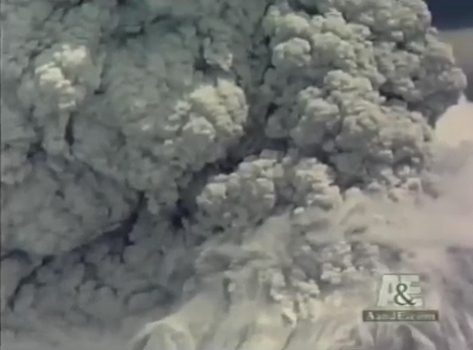
_______________________________










